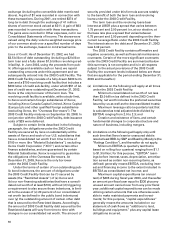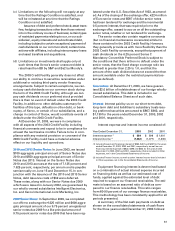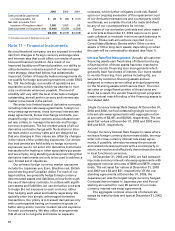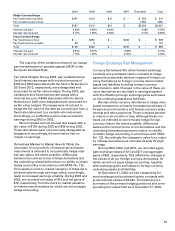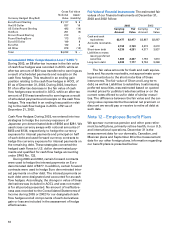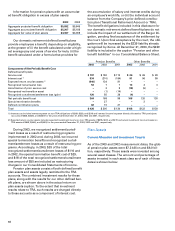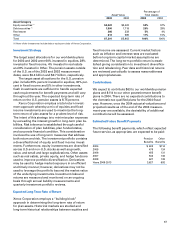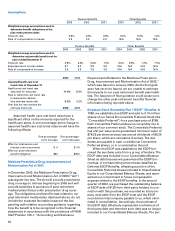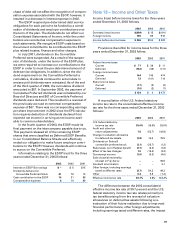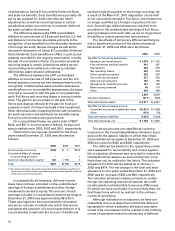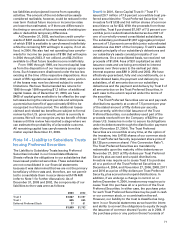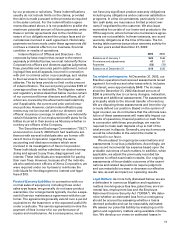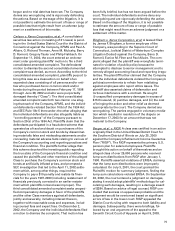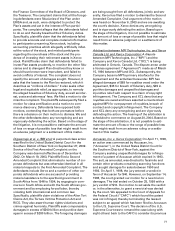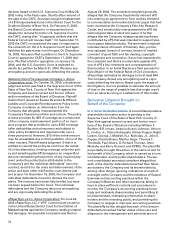Xerox 2003 Annual Report Download - page 70
Download and view the complete annual report
Please find page 70 of the 2003 Xerox annual report below. You can navigate through the pages in the report by either clicking on the pages listed below, or by using the keyword search tool below to find specific information within the annual report.
68
Assumptions
Pension Benefits Other Benefits
2003 2002 2001 2003 2002 2001
Weighted-average assumptions used to
determine benefit obligations at the
plan measurement dates
Discount rate 5.8% 6.2% 6.8% 6.0% 6.5% 7.2%
Rate of compensation increase 3.9 3.9 3.8 N/A N/A N/A
Pension Benefits Other Benefits
2004 2003 2002 2001 2004 2003 2002 2001
Weighted-average assumptions used to
determine net periodic benefit cost for
years ended December 31
Discount rate 5.8% 6.2% 6.8% 7.0% 6.0% 6.5% 7.2% 7.5%
Expected return on plan assets 8.1 8.3 8.8 8.9 N/A N/A N/A N/A
Rate of compensation increase 3.9 3.9 3.8 3.8 N/A N/A N/A N/A
2003 2002
Assumed health care cost
trend rates at December 31
Health care cost trend rate
assumed for next year 11.4% 13.8%
Rate to which the cost trend rate
is assumed to decline
(the ultimate trend rate) 5.2% 5.2%
Year that the rate reaches the
ultimate trend rate 2008 2008
Assumed health care cost trend rates have a
significant effect on the amounts reported for the
health care plans. A one-percentage-point change in
assumed health care cost trend rates would have the
following effects:
One-percentage- One-percentage-
point increase point decrease
Effect on total service and
interest cost components $ 4 $ (4)
Effect on post-retirement
benefit obligation $60 $(56)
Medicare Prescription Drug, Improvement and
Modernization Act of 2003
In December 2003, the Medicare Prescription Drug,
Improvement and Modernization Act of 2003 (“Act”)
was signed into law. The Act will provide prescription
drug coverage to retirees beginning in 2006 and will
provide subsidies to sponsors of post-retirement
medical plans that provide prescription drug cover-
age. The obligations and benefit costs related to our
post-retirement medical plan disclosed above, do not
include the expected favorable impact of the Act,
pending authoritative accounting guidance regarding
how the benefit is to be recognized in the financial
statements in accordance with the provisions of FASB
Staff Position 106-1, “Accounting and Disclosure
Requirements Related to the Medicare Prescription
Drug, Improvement and Modernization Act of 2003,”
which was issued in January 2004. As the final guid-
ance has yet to be issued, we are unable to estimate
the impacts to our post-retirement benefit plan liabili-
ties. The issuance of final guidance could cause us to
change the other post-retirement benefits financial
information being reported above.
Employee Stock Ownership Plan (“ESOP”) Benefits: In
1989, we established an ESOP and sold to it 10 million
shares of our Series B Convertible Preferred Stock (the
“Convertible Preferred”) for a purchase price of $785.
Each Convertible Preferred share is convertible into 6
shares of our common stock. The Convertible Preferred
has a $1 par value and a guaranteed minimum value of
$78.25 per share and accrues annual dividends of $6.25
per share, which are cumulative if earned. The divi-
dends are payable in cash or additional Convertible
Preferred shares, or in a combination thereof.
When the ESOP was established, the ESOP bor-
rowed the purchase price from a group of lenders. The
ESOP debt was included in our Consolidated Balance
Sheet as debt because we guaranteed the ESOP bor-
rowings. A corresponding amount was classified as
Deferred ESOP Benefits, offsetting a portion of the
Convertible Preferred shares included in Shareholders’
Equity in our Consolidated Balance Sheets, and repre-
sented our commitment to future compensation
expense related to the ESOP benefits. In the second
quarter of 2002, we purchased the outstanding balance
of ESOP debt of $135 from third-party holders. In con-
nection with this purchase, we recorded an intercom-
pany receivable from the ESOP trust and the ESOP
recorded an intercompany payable to us, which elimi-
nated in consolidation. Accordingly, the purchase of
the ESOP debt effectively represented a retirement of
third party debt and therefore such debt was no longer
included in our Consolidated Balance Sheets. The pur-




